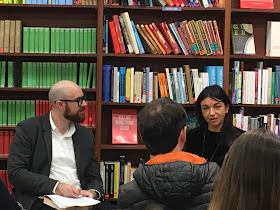Earlier this summer, I had the immense pleasure of viewing the 2019 Whitney Biennial, which is still running, for a few more weeks (until September 22, 2019), at the Whitney Museum of American Art in New York. It was not only a better show than the 2017 installment, I thought, but in essence two different exhibits in one, I ultimately argued, in a review now out for Art in America. The second of the two exhibits became possible, however, only after the Whitney resolved a festering crisis that had underpinned the exhibit--and the institution itself as a whole. In fact, the revolt that occurred, creating the new exhibition, necessitated that I rewrite the laudatory first review I'd drafted.
The qualitative differences between the two exhibits, whether visually evident or not, resonate throughout the work on display, throughout the museum's spaces itself, as a shift in ethos and an aura, however temporary. I won't replay my entire essay, which underwent a great deal of editorial distilling (so many thanks to Will Ratik and his editorial team at Art in America), so here is the link to the full essay, "The Whitney Biennial: A Tale of Two Exhibitions," and a paragraph from it, in which I argue for further action by the exhibits artists and, I would assert, artists working in all media, including literature.
The qualitative differences between the two exhibits, whether visually evident or not, resonate throughout the work on display, throughout the museum's spaces itself, as a shift in ethos and an aura, however temporary. I won't replay my entire essay, which underwent a great deal of editorial distilling (so many thanks to Will Ratik and his editorial team at Art in America), so here is the link to the full essay, "The Whitney Biennial: A Tale of Two Exhibitions," and a paragraph from it, in which I argue for further action by the exhibits artists and, I would assert, artists working in all media, including literature.
I believe we are at the moment when the artists should be encouraged to actively trouble the “circuits of valorization,” as prior generations of artists have done. I say trouble rather than disrupt, since the latter term has taken on particular connotations in the language of neoliberal capitalism, particularly in Silicon Valley and Wall Street. But what might the effects be of such a troubling on the lives and careers of today’s artists, especially those who, like many of this year’s biennial participants, come from groups, intersectionally understood, that have been traditionally excluded from participation in exhibitions such as this, as well as from elite art schools and institutions, and from the global gallery, art fair, and auction networks? What would more extensive rethinking, dismantling, and transformation of those circuits look like? How much energy and effort can and ought they expend in understanding and critiquing the ecosystem in which they are working? From an ethical standpoint, can they forgo such an undertaking, whatever the cost?If you can, please see the exhibit before it goes, and do leave your thoughts on the Biennial and my review in the comments section if you'd like.



























































